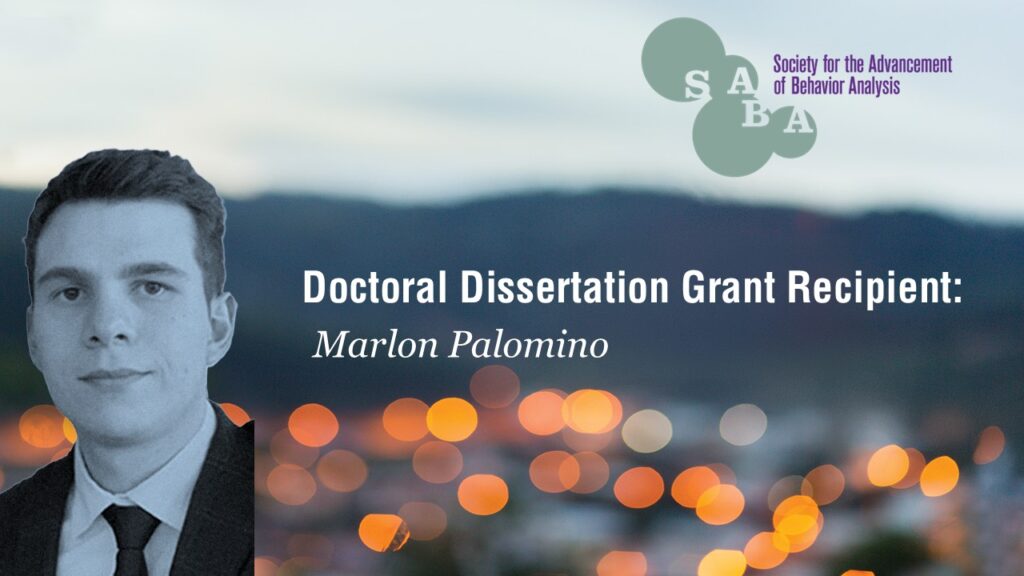Doctoral Dissertation Grant Recipient: Marlon Palomino

Marlon is a second-year doctoral student in the Psychology PhD program at Universidad Nacional de Educación a Distancia in Madrid, Spain. His research interests include, on one side, the experimental analysis of behavior and the basic processes that control the extinction burst (EB), a phenomenon that has regained relevance due to the lack of empirical evidence and control of the learning processes that govern it, raising doubts about its ubiquity (Katz & Lattal, 2020, 2021; Lattal et al., 2020; Nist & Shahan, 2021). On the other side, he is interested in the applied field, where the EB is highly relevant due to the clinical significance of its consequences. Understanding the variables and basic processes that give rise to extinctionrelated increases in problem behavior is critical to further improve the effectiveness of function-based treatments (like FCT) and extinction-based treatments, which are used in everyday human problems and enhance people’s quality of life (Fisher et al., 2022). Thus, rigorous basic research will contribute enormously to addressing these questions.
Marlon’s PhD research is conducted under the supervision of Dr. Ricardo Pellón and Dr. Gabriela E. López-Tolsa. His overall strategy involves two approaches to systematize the EB and to understand under what conditions it can be predicted or not. The first approach arises from the Temporally Weighted Matching Law (Shahan, 2022), the most recent theory and, apparently, the best positioned to explain the EB. The second approach involves a hypothesis regarding the specific reinforcement history of the phenomenon. SABA’s Innovative Student Research Grant will support Marlon’s current PhD project by funding resources to carry out experiments in the Animal Learning and Behavior Laboratory (UNED), including those necessary to obtain and maintain the experimental subjects in excellent conditions.
Marlon is honored to receive this research grant, and hopes these efforts to be fruitful in the short and long term for behavior analysis and people’s quality of life, and looks forward to sharing the results of his experiments at next year’s annual convention in Washington, D.C.
References:
- Fisher, W. W., Greer, B. D., Shahan, T. A. & Norris, H. M. (2022). “Basic and applied research on extinction bursts.” Journal of Applied Behavior Analysis, 9999, 1-25. https:// doi.org/10.1002/jaba.954
- Katz, B., & Lattal, K. A. (2020). “An experimental analysis of the extinction-induced response burst.” Journal of the Experimental Analysis of Behavior, 114(1), 24-46. https://doi. org/10.1002/jeab.611
- Katz, B. R., & Lattal, K. A. (2021). “What is an extinction burst?: A case study in the analysis of transitional behavior.” Journal of the Experimental Analysis of Behavior, 115(1), 129- 140. https://doi.org/10.1002/jeab.642
- Lattal, K. A., Kuroda, T., & Cook, J. E. (2020). “Early extinction effects following intermittent reinforcement: Little evidence of extinction bursts.” Journal of the Experimental Analysis of Behavior, 114(1), 47–59. https://doi. org/10.1002/jeab.616
- Nist, A. N., & Shahan, T. A. (2021). “The extinction burst: impact of reinforcement time and level of analysis on measured prevalence.” Journal of the Experimental Analysis of Behavior, 116, 131–148. https://doi.org/10.1002/ jeab.714
- Shahan, T. A. (2022). “A theory of the extinction burst.” Perspectives on Behavior Science 45, 495-519. https://doi.org/10.1007/ s40614-022-00340-3


